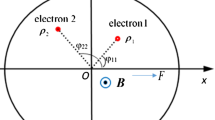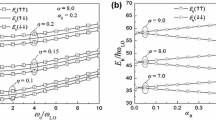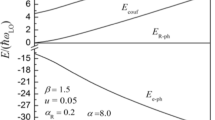Abstract
Based on Lee-Low-Pines (LLP) unitary transformation, this article adopts the variational method of the Pekar type and gets the energy and wave functions of the ground state and the first excited state of strong-coupling bipolaron in two-dimensional quantum dot in electric field, thus constructs a bipolaron qubit. The numerical results represent that the time oscillation period T 0 of probability density of the two electrons in qubit decreases with the increasing electric field intensity F and dielectric constant ratio of the medium η; the probability density Q of the two electrons in qubit oscillates periodically with the increasing time t; the probability of electron appearing near the center of the quantum dot is larger, while that appearing away from the center of the quantum dot is much smaller.
Similar content being viewed by others
References
J I Cirac and P Zoller, Phys. Rev. Lett. 74, 4091 (1995).
N A Gershenfeld and L Chuang, Science 275, 350 (1997).
B E Kane, Nature 393, 133 (1998).
D Loss and D P DiVincenzo, Phys. Rev. A 57, 120 (1998).
A N Jordan and M Büttiker, Phys. Rev. B 71, 125332 (2005).
S Furuta, C H W Barnes and C J L Doran, Phys. Rev. B 70, 205320 (2004).
S S Li, G L. Long, F S Bai, S L Feng and H Z Zheng, Proc. Nat. Acad. Sci. USA 98, 11847 (2001).
S S Li, J B Xia, F H Yang, Z C Niu, S L Feng and H Z Zheng, Appl. Phys. 90, 6151 (2001).
J L Xiao, Quantum Inf. Process 12, 3707 (2013).
Y Sun, Z H Ding and J L Xiao, J. Low Temper. Phys. 177, 151 (2014).
Eerdunchaolu and W Xin, Physica B 406, 358 (2011).
Y W Zhao, C Han, W Xin and Eerdunchaolu, Superlattices Microstruct. 74, 198 (2014).
T D Lee, F M Low and D. Pines, Phys. Rev. 90, 97 (1953).
T Yildirim and A J Ercelebi, Phys. Conden. Matt. 3, 1271 (1999).
Author information
Authors and Affiliations
Corresponding author
Additional information
This work has been supported by the Natural Science Foundation of Hebei Province (No.E2013407119) and the Items of Institution of Higher Education Scientific Research of Hebei Province (Nos.ZD20131008 and Z2015149).
Rights and permissions
About this article
Cite this article
Zhang, Y., Han, C. & Eerdunchaolu Characteristics of strong-coupling bipolaron qubit in two-dimensional quantum dot in electric field. Optoelectron. Lett. 11, 386–389 (2015). https://doi.org/10.1007/s11801-015-5135-6
Received:
Published:
Issue Date:
DOI: https://doi.org/10.1007/s11801-015-5135-6




